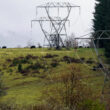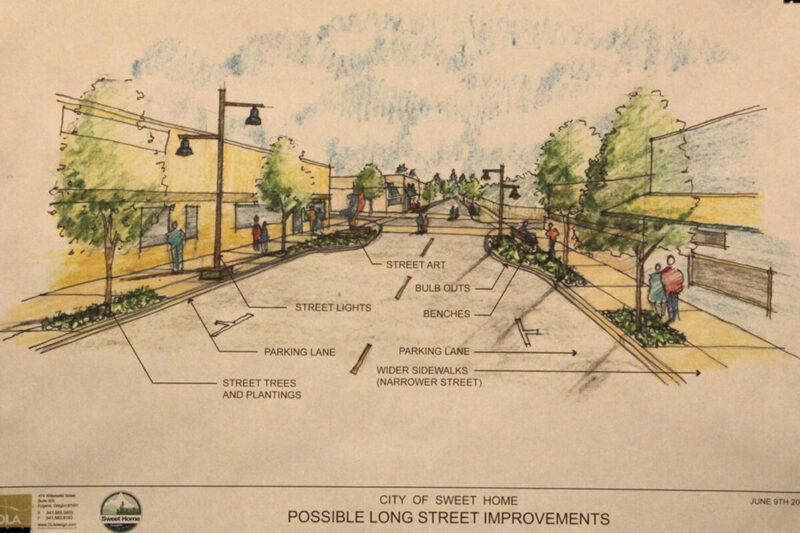Benny Westcott
The Sweet Home City Council and Planning Commission held a joint work session on June 15 at city hall to discuss plans for streetscape improvements in the downtown corridor.
This was the second public meeting this year regarding the subject of making downtown Sweet Home more pedestrian friendly.
“The point of a streetscape plan is to have a cohesive plan for the whole downtown,” said Community and Economic Development Director Blair Larsen.
“It includes pedestrian amenities, sidewalk amendments, street furniture, artwork, lighting that is more pedestrian friendly, and other improvements that make a downtown more of an inviting destination and a place where people are attracted to be. And then, businesses are also attracted to be there to take advantage of the traffic coming to that space.”
The city put out a request for proposal last fall, and Dougherty Landscape Architects (DLA), located in Eugene, was hired.
An initial public meeting was held on March 25, and was well attended. At that meeting DLA presented some of their early ideas and heard feedback from the attending public.
DLA’s proposed improvements are focused on Long Street and Main Street from Ames Creek to 18th.
David Dougherty of DLA said “Sweet Home’s a great place. It has a lot of great bone structure and great architecture. There’s just so much more potential though.”
“Our goal is to make Sweet Home more pedestrian friendly and welcoming,” he said, “but many of the streets are extremely wide, way wider than what is needed for typical truck and standard everyday traffic. So there’s opportunities to reduce some of the streets and make the pedestrian realm a little bit more in balance with the streets.”
Dougherty noted that “Long Street is a wider street than is necessary. The travel lanes are 14 feet wide, which is wider than I-5. They don’t need to be that wide.”
In response to the unnecessarily wide street, Dougherty presented images of Long Street with a narrow street and widened sidewalk, noting that “if we reduce the 14 feet travel lanes to 11 feet, we have six feet to work with.”
He showed one option in which six feet of sidewalk is added to the south side of Long Street, and another in which three feet of sidewalk are added on each side of Long.
“By adding to the sidewalks, suddenly you have opportunities for street trees, lights, plantings and pedestrian amenities,” Dougherty said.
Speaking about current issues he sees on Long, Dougherty said “right now as you’re walking along Long Street on the north side, the street trees are basically right in the middle of the sidewalk, which is not ideal, especially if you’re in a wheelchair or have visual impairments.”
Multiple meeting attendees noted their preference for focusing streetscape improvements on Main Street as opposed to Long Street.
Planning Commision Chairman Jeff Parker questioned “redoing all the sidewalks and spending 60% of this budget on Long Street when our main objective for this from the beginning was to draw pedestrian traffic to Main Street. That’s where the businesses are.”
Planning Commissioner David Lowman said: “If we’re going to spend a lot of money on the city, I’d like to see more spent on Main Street. Main Street is the gateway to Sweet Home. When people drive in from Lebanon or Albany into Sweet Home, the first thing they see is our businesses. And those businesses need to go ‘wow’ so people can pull off and shop.”
Lowman added, “I think we need to upgrade Main Street more than what we do in Long Street, because those businesses that are on Main Street need to thrive. And they need to also work with the city by updating their buildings, but we need to spend some more money on Main Street.”
Mayor Greg Mahler argued for improving Long Street as well as Main.
“We can’t lose sight of the emphasis on our downtown businesses, because that is important. But on the same token we cannot lose sight of our Long Street businesses, because they are just as important,” Mahler said.
Along with enhancing the walkability of sidewalks with improved pedestrian amenities, Dougherty said “gathering spaces are important. You have a couple festivals every year. Where do they go when they come downtown? We want to give some consideration to those spaces.”
Dougherty shared sketches of a potential festival street on 13th, a top “gathering space” candidate that emerged from the first public meeting in the spring. He proposed blocking either part or all of the street off to traffic at certain times to hold events there.
About an hour into the meeting, attendees began discussing the parking situation in downtown Sweet Home.
Larsen said that in the downtown area, “when it comes to areas that could be devoted to parking, there is an astonishing amount of parking. There’s just a ton of space available. The problem is that it’s all divided up among the various property owners.”
Larsen said “if we can help people to realize that they have a lot in common and that cooperating on parking would really benefit everyone, it would make it a lot easier for everyone in town to park and to have good access to various businesses. We have plenty of space, we just don’t have it allocated in a way that is understandable to people, because they’re worried about parking on private property where they’re not allowed to park, or so forth.”
Mahler added “when you come into Sweet Home, a lot of people don’t realize there’s parking behind the businesses downtown. There’s tons of it. I don’t know if we necessarily have the proper signage letting people know that there’s parking behind.”
Larsen agreed, saying “I think signage can make a huge impact. And I think also there’s an education component. In the downtown that we want to create, we want to create opportunities for people to patronize more than one business per trip. We want people to get out and walk around and go to multiple businesses, and then go back to their car.”
“To do that, you have to have these cooperative parking arrangements in place,” he added. “But you also have to help people realize that you don’t need parking right in front of your business, because we want to promote that walking around bit. Sure, when you go to a shopping center it’s convenient to be able to park right in front of the store, but it’s not realistic for a downtown area unfortunately.”
Mahler said, “We have some business owners that are selfish in allowing the use of their parking. And to me, that’s not a pro-business mindset. I think that all business owners should work together to allow parking throughout all of downtown. That’s how you’re going to improve your business.”
Mahler concluded that “we have a parking problem, but we don’t have a parking problem. I think a lot of it is signage, communication, and working as one as a community with all the business owners coming together. It’s that simple.”





